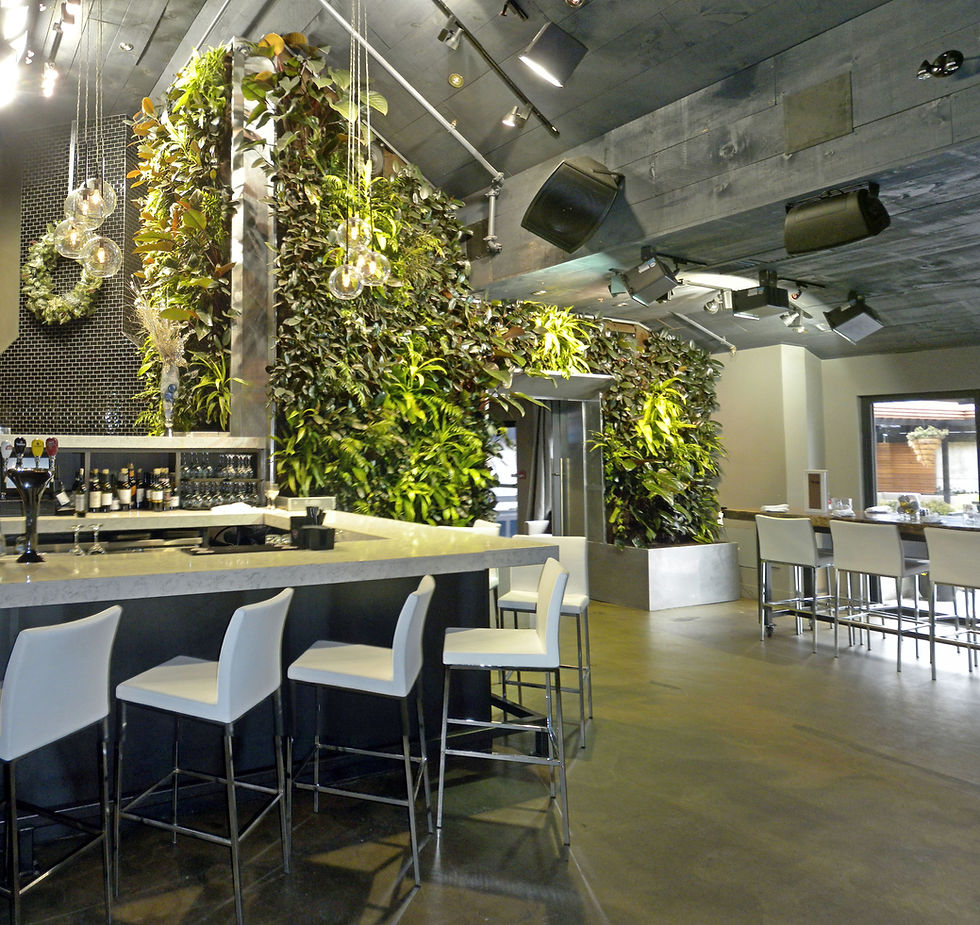Energy Conservation and Indoor Air Biofilters
- Nedlaw Living Walls
- Aug 2, 2021
- 4 min read

Longo’s Maple Leaf Square, Toronto, ON
Introduction
The presented data is based upon theoretical calculations. We are not suggesting a mechanical system be designed outside guidelines set out by ASHRAE. We present this as an indication of the sort of the energy savings could be potentially experienced.
Background
The traditional means of maintaining indoor air quality is to displace the ‘dirty’ air within the building with new outside air. Since the outside air quality in Canada is generally very good, this method can be extremely effective at controlling the build up of pollutants with the space. However, before being disseminated in the space, the additional air must be conditioned to an appropriate temperature to ensure occupant comfort. For buildings with central air handling systems, the ideal temperature of the disseminated air is 15°C. This allows for heat removal from activities within the space. The conditioning of this additional flow of air can represent a substantial cost to building owners. Under normal operating conditions, approximately 10–20% and during temperature extremes, over 30% of the energy consumed by the building is used to condition this additional flow of air. As a consequence of energy conservation concerns, many buildings may not be delivering enough outside air to the occupants. This can lead to a decrease in the air quality which can reduce the well-being of the occupants. Biofiltration of the air circulating within the building is an alternative means of refreshing the indoor air without having to bring new expensive outside air into the building. This could lead to substantial energy savings without sacrificing air quality.
Traditional Energy Requirements to Air Quality
Most indoor spaces require delivery of new outside air to the occupants at a rate of 8 to 10 liters per second per person (ASHRAE 1989). Given these flow rates, the density of air and its specific heat, it is possible to calculate the amount of energy required to heat this amount of new air over a range of temperatures typically encountered in North American cities. This is presented below.

The above figure represents only the energy required to heat the air and does not reflect the energy associated with the humidity management. Most warm air is frequently also humid and the removal of this excessive moisture represents a substantial energy requirement.
Further, cold air is inherently dry, adding the required moisture to make the air acceptable to the occupant is also very energy intensive. For example, adding enough water vapour to the air originally at -25°C to make in comfortable at 20°C increases the energy demand by close to fifty percent (0.42 KW per person to simply heat the air to 0.62 KW per person for properly humidified air).
Considering air at 30°C and 80%RH, to cool an adequate volume of air to 15°C requires 0.16 KW per person and to concurrently cool and dehumidify requires approximately 0.36 KW per person of cooling energy.
Energy requirements of the biofilter

Ivy Restaurant
The operation of the biofilter is not without its own energy costs. The two largest energy consumption processes are the pumps to deliver the water to the hydroponic wall and lighting. The energy required for both of these is very much dependent on the configuration of the system. A typical system requires approximately less than 10 W per m2 for the pump to circulate water. The green plants on the wall require light of at least 100 W per m2 but this can be augmented or replaced with natural lighting. An additional 10 W per m2 is required for the fans to draw air through the wall. Therefore, assuming natural lighting is not available; the operation of the biofilter requires approximately 0.120 KW per m2 or approximately 0.25 KW per building occupant (assuming 5 occupants per m2 ). If the system is naturally lit than energy consumptions falls to less than 5 W per occupant.
Energy Saving with Biofilter
Assuming that air flows through the biofilter at 0.05 m3 air s-1 m2 biofilter with an average removal efficiency of 50%, this is equivalent to 25 litres of new outside air s-1 m2 biofilter. Assuming a density of occupants of 1 person per 20m2 of floor space and a ratio of 1m2 of biofilter per 100m2 of floor space (recommend ratio), the biofilter could provide 60% of the ‘fresh air’ requirements of the occupants. This translates into a saving during peak energy requirements during the heat of summer and the cold of winter of 0.3 and 0.58 KW per occupant respectively. These calculations are for the absolute amount of cooling and heating required and do not take into account the use of heat pumps, etc. which would reduce the power requirements (i.e. an efficient heat pump can generate 4 KW of cooling while consuming only 1 KW of electrical power). If this sort of system is in place then the biofilter is still generating clean air using less than half the energy of the traditional system.
Caveat
Any energy savings efficiencies gained by the installation of an indoor biofilter will be influenced by mechanical considerations of the building such as the type of HVAC used and its effectiveness at moving the air through the space. Climatic factors will also affect energy savings. If the outside air temperature is near ideal temperature of 15°C than no conditioning of the air would be required (hence the term ‘free cooling’). The more extreme the climate, the more energetically beneficial the biofilter is.
Originally published by:
Alan Darlington, PhD, is a researcher in addition to being the founder and director of Nedlaw Living Walls. In 2001, after his first award of the Martin Walmsley Fellowship, Dr. Darlington commercialized the product of this research through the company, Air Quality Solution, which merged in 2008 with the Nedlaw Group to form Nedlaw Living Walls.

Comments